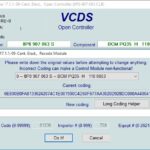Understanding your Audi’s performance and diagnosing potential issues often requires delving into its diagnostic data. VCDS (Vag-Com Diagnostic System) provides access to this data through Measuring Blocks, offering valuable insights into various vehicle systems. This guide explores the key Measuring Blocks for Audi vehicles, outlining their functions and typical value ranges. Using VCDS and accessing these measuring blocks allows for precise diagnostics and informed maintenance decisions.
Decoding Audi Measuring Blocks with VCDS
Measuring Blocks are sets of data points representing real-time values from various sensors and systems within your Audi. These values, accessible via VCDS, enable you to monitor engine performance, emissions, transmission behavior, and more. Each block is assigned a specific group number, and within each group, individual fields represent different parameters.
Essential Measuring Block Groups for Audi
Here’s a breakdown of some crucial Measuring Block groups and the information they provide:
Group 000: Basic Engine Data
This group displays fundamental engine parameters at idle:
- Engine Idle Speed: Typically ranges from 870-950 RPM.
- Start of Injection: Indicates injection timing, ranging from 2 degrees ATDC (After Top Dead Center) to 3 degrees BTDC (Before Top Dead Center).
- Throttle Position: Shows the percentage of throttle opening.
- Injection Quantity: Represents the amount of fuel injected per stroke (2.2 – 9.0 mg/stroke).
- Manifold Absolute Pressure (MAP): Reflects intake manifold pressure.
- Engine Coolant Temperature: Displays the engine’s operating temperature (80 – 110 degrees C).
- Intake Manifold Temperature: Measures the temperature of the air entering the engine (10 – 110 degrees C).
- Fuel Temperature: Indicates the temperature of the fuel (20 – 80 degrees C).
- Air Mass: Shows the mass of air entering the engine (230 – 370 mg/H).
Group 001: Injected Quantity
Focuses on fuel injection:
- Engine RPM: Displays current engine speed.
- Injected Quantity: Shows fuel injected per stroke (2.2 – 9.0 mg/H). Values outside this range may indicate rich or lean running conditions.
- Modulating Piston Displacement Sensor Voltage: Reflects the fuel pump’s injection quantity adjuster.
Group 003: EGR (Exhaust Gas Recirculation)
Monitors the EGR system:
- Air Mass Drawn In (Specified & Actual): Compares desired and actual air intake. Discrepancies might indicate EGR issues or air leaks.
- EGR Vacuum Solenoid Duty Cycle: Shows the percentage of time the EGR solenoid is activated.
Group 004: Start of Injection
Provides detailed injection timing data:
- Start of Injection (Specified & Actual): Allows comparison of target and actual injection timing. Deviations can signal injection pump or cold start injector problems.
Group 011: Charge Pressure Control
Monitors turbocharger boost pressure:
- Engine RPM: Displays engine speed.
- Specified MAP: Shows the target boost pressure.
- Actual MAP: Displays the measured boost pressure.
- MAP Valve Duty Cycle: Indicates the control of the boost pressure regulating valve.
These are just a few of the many VCDS Measuring Blocks available for Audi diagnostics. Consulting the official Ross-Tech VCDS documentation for your specific Audi model is crucial for comprehensive information and accurate interpretation of data.
Conclusion
VCDS and its Measuring Block functionality offer an indispensable tool for in-depth analysis of your Audi’s performance. By understanding the data provided in these blocks, you can effectively pinpoint problems, optimize performance, and ensure the long-term health of your vehicle. Remember to always refer to the official Ross-Tech documentation for accurate interpretations specific to your Audi model.

